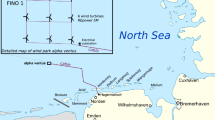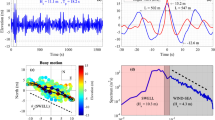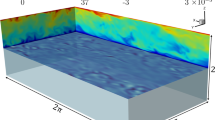Abstract
IN a letter published in NATURE on August 19, 1920, p. 777, I said that, judging from appearances, wind-formed waves increased in length only when the waves were in a “breaking” condition, and it was suggested that the breaking crests, by imparting their momentum to the upper strata of the water, and so establishing a gradually increasing surface current, would necessarily also cause a gradual increase in the wavelength equal to the increase of stream speed per wave-length × by the period of the wave. An example of the alteration in the lengths of a train of breaking waves may be seen at the foot of any weir where the flow is sufficient to form a stationary “bore.” The wave where the stream over the apron is first arrested carries a large breaking crest, and down-stream follow several waves also breaking, but not so heavily. Following these again are waves which do not break, and counting from the first wave, observation will show that the distance from crest to crest diminishes notably so long as the waves are breaking.
This is a preview of subscription content, access via your institution
Access options
Subscribe to this journal
Receive 51 print issues and online access
$199.00 per year
only $3.90 per issue
Buy this article
- Purchase on Springer Link
- Instant access to full article PDF
Prices may be subject to local taxes which are calculated during checkout
Similar content being viewed by others
Author information
Authors and Affiliations
Rights and permissions
About this article
Cite this article
MALLOCK, A. Wind and Waves. Nature 114, 679–680 (1924). https://doi.org/10.1038/114679a0
Issue Date:
DOI: https://doi.org/10.1038/114679a0
Comments
By submitting a comment you agree to abide by our Terms and Community Guidelines. If you find something abusive or that does not comply with our terms or guidelines please flag it as inappropriate.



